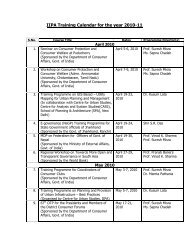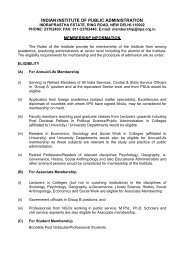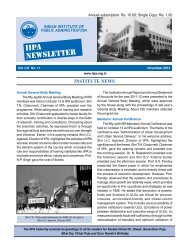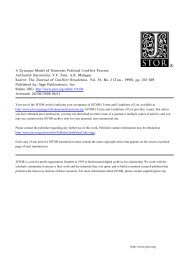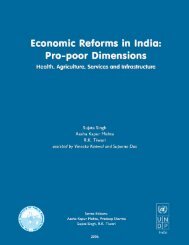Privatisation of Health Care in India - Indian Institute of Public ...
Privatisation of Health Care in India - Indian Institute of Public ...
Privatisation of Health Care in India - Indian Institute of Public ...
- No tags were found...
You also want an ePaper? Increase the reach of your titles
YUMPU automatically turns print PDFs into web optimized ePapers that Google loves.
<strong>Privatisation</strong> <strong>of</strong> <strong>Health</strong> <strong>Care</strong> <strong>in</strong> <strong>India</strong>3.1. Evolution <strong>of</strong> <strong>Health</strong> Services <strong>in</strong><strong>India</strong> from the Forties to the lateN<strong>in</strong>eties<strong>Health</strong> services development <strong>in</strong> <strong>India</strong> can broadly be divided<strong>in</strong>to three phases. The first phase <strong>of</strong> developmentwas the post-Independence period, which witnessed thegrowth <strong>of</strong> health services <strong>in</strong> the public sector up to theseventies. Investments <strong>in</strong> the health sector were meagre,but an effort was made to build a network <strong>of</strong> services <strong>in</strong>both rural and urban areas. This phase was followed bythe period from the late seventies to the late eighties whenthere were cutbacks on public spend<strong>in</strong>g and concessionsgiven to the private sector. Dur<strong>in</strong>g the third phase <strong>India</strong>went <strong>in</strong> for loans from the IMF and World Bank. This wasthe period when several state governments received loansfor reform<strong>in</strong>g the publicly provided health services.Like many <strong>of</strong> the newly liberated countries dur<strong>in</strong>g the 20 thcentury, the leadership <strong>of</strong> the <strong>India</strong>n nationalist movementhad committed itself to pr<strong>in</strong>ciples <strong>of</strong> universality and anationalised health service system to ensure that all sections<strong>of</strong> the population get access to services. The vision at thatpo<strong>in</strong>t <strong>in</strong> time was to build self-reliance <strong>in</strong> the economy andsocial sectors and hence, <strong>in</strong> health care, the emphasis wason the development <strong>of</strong> <strong>in</strong>stitutions, manpower, research,pharmaceuticals and technology.The nationalist movement and its commitment to democraticpolitics played a very important role <strong>in</strong> ensur<strong>in</strong>g thatthe needs <strong>of</strong> the majority were represented (Bhargava,2000). This understand<strong>in</strong>g received support from varioussections <strong>of</strong> civil society that <strong>in</strong>cluded the political parties,big bus<strong>in</strong>ess groups, pr<strong>of</strong>essional bodies and others. It is<strong>in</strong>deed <strong>in</strong>terest<strong>in</strong>g to note that different sections <strong>of</strong> thepolitical spectrum had clearly articulated the need for astate-supported health service system. These sections <strong>in</strong>cludedthe national bourgeoisie, the left parties and the <strong>India</strong>nNational Congress. Each <strong>of</strong> them had clarified theirrespective positions through well-articulated plandocuments.Given the poor health <strong>of</strong> a majority <strong>of</strong> <strong>India</strong>ns, the thrustwas to <strong>in</strong>vest <strong>in</strong> preventive and curative care <strong>in</strong> addition toimprov<strong>in</strong>g the overall liv<strong>in</strong>g conditions <strong>of</strong> the population.The Bhore Committee report (Government <strong>of</strong> <strong>India</strong>, 1996)was an attempt at design<strong>in</strong>g a health service system basedon the needs <strong>of</strong> the majority who belonged to the deprivedsections <strong>of</strong> the population. As the Bhore Committeeobserved, the majority <strong>of</strong> the <strong>India</strong>n population wassuffer<strong>in</strong>g from malnutrition and anaemia. The major killerswere a host <strong>of</strong> communicable diseases more commonlyreferred to as diseases <strong>of</strong> the poor. Therefore, thepolitical leadership had to take cognisance <strong>of</strong> the extent <strong>of</strong>the problem and tackle it through state <strong>in</strong>vestment, s<strong>in</strong>cethe market was restricted to <strong>in</strong>dividual private practitioners,both <strong>in</strong> allopathic and other systems <strong>of</strong> medic<strong>in</strong>e.Due to limited private capital, even the representatives <strong>of</strong>big bus<strong>in</strong>ess houses relied on state <strong>in</strong>vestment <strong>in</strong> educationand health.With<strong>in</strong> the health services, the pr<strong>of</strong>essional organisationssupported state <strong>in</strong>vestment, but did not want it to <strong>in</strong>terferewith their autonomy to cont<strong>in</strong>ue private practice. It is <strong>in</strong>deed<strong>in</strong>terest<strong>in</strong>g that while the ‘left’ parties called for theabolition <strong>of</strong> private <strong>in</strong>terests with<strong>in</strong> the medical and pharmaceuticalsectors, the pr<strong>of</strong>essional bodies wanted thedoctors to be allowed to cont<strong>in</strong>ue their private practice.The Bhore committee accommodated the <strong>in</strong>terests <strong>of</strong> thepr<strong>of</strong>essional bodies by not tak<strong>in</strong>g measures to elim<strong>in</strong>ateprivate <strong>in</strong>terests both with<strong>in</strong> and outside the public healthservice system.Thus, even at the time <strong>of</strong> Independence a substantial percentage<strong>of</strong> government doctors were practic<strong>in</strong>g <strong>in</strong> the privatesector as <strong>in</strong>dividual practitioners, but the number <strong>of</strong><strong>in</strong>stitutions was very small. Private <strong>in</strong>terests were also present<strong>in</strong> the pharmaceutical <strong>in</strong>dustry dur<strong>in</strong>g this period (Jesaniand Anantharam, 1993; Baru, 1998).A survey <strong>of</strong> the health status <strong>of</strong> the population dur<strong>in</strong>g thelate forties revealed that death rates, <strong>in</strong>fant mortality andmaternal mortality rates were very high and the major causes<strong>of</strong> death were a host <strong>of</strong> communicable diseases. Keep<strong>in</strong>g<strong>in</strong> view the poor health conditions <strong>of</strong> the majority, thereport emphasised the need for strong primary health careservices supported by secondary and tertiary levels <strong>of</strong> care.It was estimated that around 12 percent <strong>of</strong> the GNP would8




